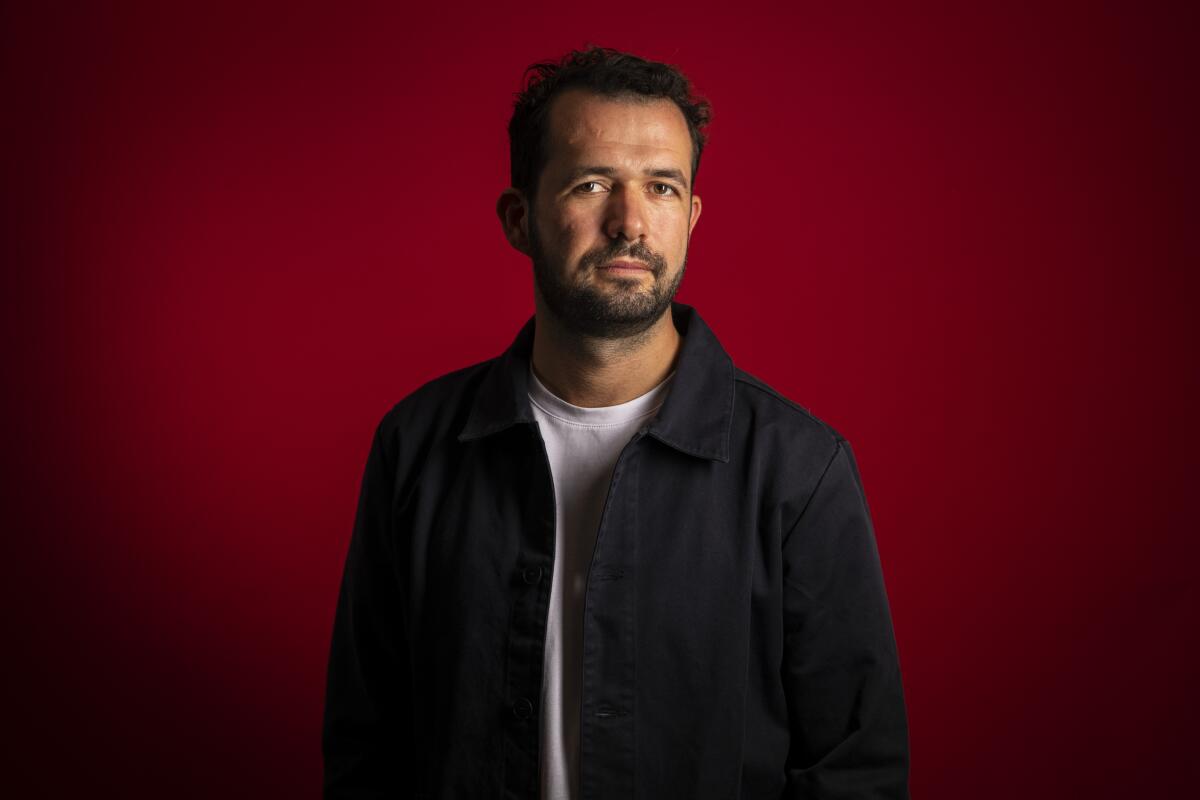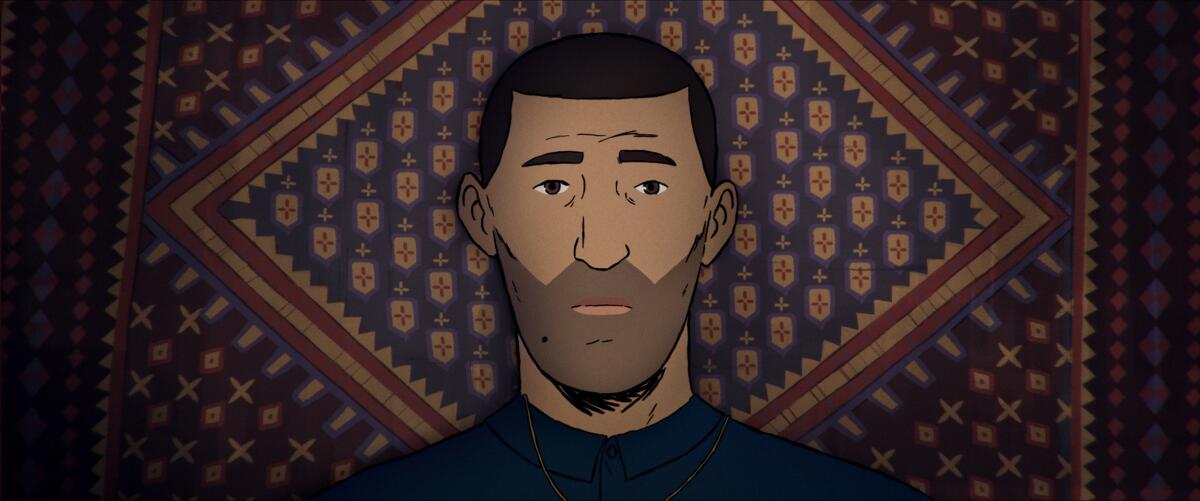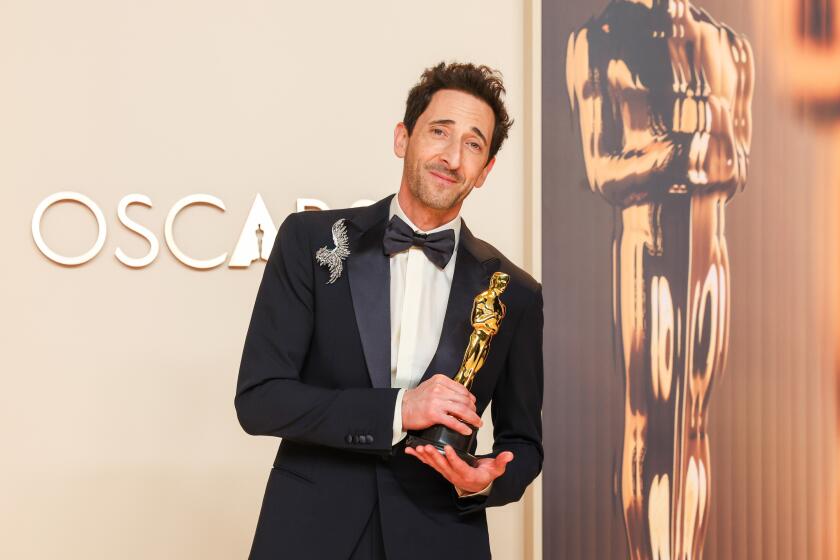‘Flee’: One man’s story of escape from Afghanistan, one filled with danger and secrets

- Share via
Everyone has secrets. Some big, some small. Danish filmmaker Jonas Poher Rasmussen was keenly aware that one of his childhood friends had a story so traumatic that he’d kept it a secret from everyone close to him for decades. Until recently, he had never truly been forthcoming about how, as a young refugee, he’d made his way from Afghanistan to Denmark in 1995. That journey, in all its horrors and triumphs, is finally and vividly brought to life in Rasmussen’s acclaimed animated documentary, “Flee.”
That friend, who uses the pseudonym Amin in the film, escaped from Afghanistan when the Mujahideen set siege on the nation’s capital, Kabul, in the early 1990s. Initially, he joined one of his brothers, two sisters and mother on a treacherous journey across a number of international borders. The refugees eventually found themselves in Moscow, scrounging for food and trying to avoid deportation by the local authorities. But it was just Amin who arrived in Copenhagen. And to anyone who asked, he’d insist that the Mujahideen had killed his family and that he’d walked all the way to Denmark alone. The secrets continued.
A little over a decade ago, Rasmussen asked Amin if he could produce a radio documentary about his story. At that point, Amin’s life had changed for the better. He’d attended Princeton University in the U.S. and had a serious boyfriend. Life was good. And yet, his answer was still no. After attending a workshop for animators and documentary filmmakers at Anidox a few years later, Rasmussen decided to approach his friend once again. This time, Amin was ready to talk. He had his own reasons, but Rasmussen’s pitch on the structure of the project was a major selling point.
“Because with the animation, we could make him anonymous,” Rasmussen notes. “What you see in the film is the very first time he tells his story to anyone. It’s such a traumatic story for him. And he felt like if he should tell it, being anonymous would kind of help because then every time he met someone, he wouldn’t have to think about if they have seen the film and if they would know about his innermost secrets and his traumas.”
Rasmussen makes it clear, however, that the then-36-year-old Amin was at a place in his life where telling his story to anyone mattered more than the film itself. He notes, “Amin told me in the beginning, ‘I actually don’t care if the film’s going to be made. To me, it’s really just to get it out there, to tell it. And then I think it will help me a lot,’ because then he can take a deep breath. ‘OK, now my story is out there and someone in the world knows everything.’”
“Flee” is in contention for animation, documentary and international film Oscar nominations, but animated documentaries are nothing new (2008’s “Waltz With Bashir” became the first feature-length animated film nominated for the documentary Oscar). Despite Rasmussen’s filmmaking experience, however, animation was a new world for him. It was a gut instinct, validated after he screened a preliminary version of the project to his peers.

“I could feel when I showed it to people that they kind of did this little move in their seats and kind of leaned forward because they hadn’t seen something like this before,” Rasmussen recalls. “We just had a very, very powerful reception from the people we showed it to. They were really moved by it. That was where I felt, ‘We’re doing something special.’”
That step also informed him that authenticity was key. Choosing an animation aesthetic that might seem too “cartoony” would be going in the wrong direction. The characters on-screen needed to feel flawed and human.
“The lines are a little crooked. It’s not always a straight line. So really keeping authenticity throughout,” Rasmussen says. “And, also with the art direction, we have all this archival [footage] in the film to really pull information from and bring that into the animation. We also had a bunch of Afghan consultants who had lived in Afghanistan in the ’80s to see what we were designing and comment if things felt right.”
After he showed Amin some of the early tests, it became clear that attention to historical details had paid off. Rasmussen recalls, “We have this sequence where [young Amin] plays volleyball, and he was really thrown back because he was like, ‘I had that blue jumper suit that he’s wearing while playing volleyball.’ And all the windows, the architecture of Kabul is exactly like he remembered.”
While “Flee” gave Amin a cathartic opportunity to tell his harrowing story to the world, Rasmussen’s cinematic achievement has already been felt far beyond Denmark.
“I was at the New York Film Festival, and these two young men from the Dominican Republic who came to me and you could see their eyes were all wet,” Rasmussen recalls. “And they’re like, ‘Thank you for telling this because this is our story as well.’ That really means a lot, people who feel like they are represented by the story, whether they’re gay or refugees. It’s really powerful.”
- Share via
Watch L.A. Times Today at 7 p.m. on Spectrum News 1 on Channel 1 or live stream on the Spectrum News App. Palos Verdes Peninsula and Orange County viewers can watch on Cox Systems on channel 99.
More to Read
From the Oscars to the Emmys.
Get the Envelope newsletter for exclusive awards season coverage, behind-the-scenes stories from the Envelope podcast and columnist Glenn Whipp’s must-read analysis.
You may occasionally receive promotional content from the Los Angeles Times.











